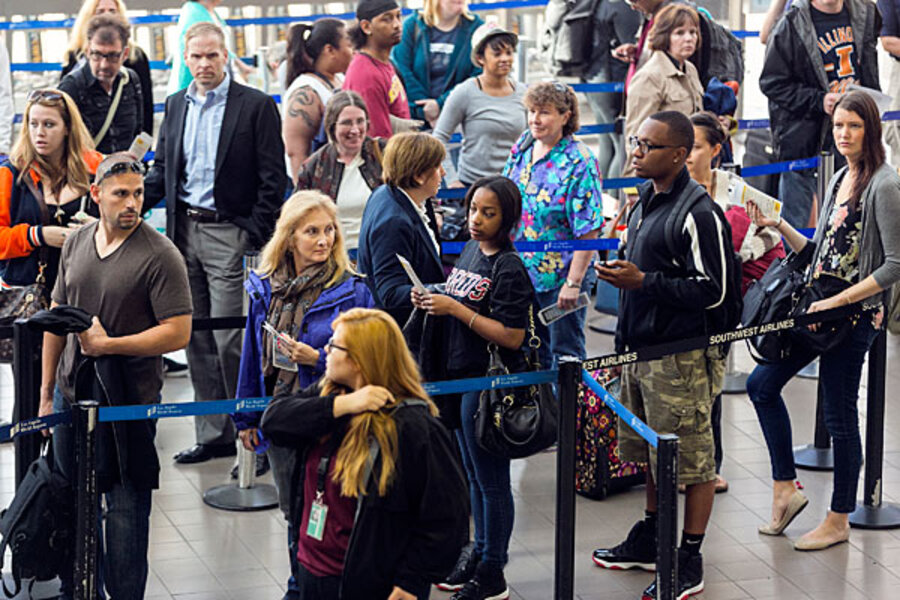Will flight delays stir up ire against sequester?
Loading...
Rolling flight delays. Cancellations. Heavy sighs and grim smirks in packed airport concourses. Has the sequester, Washington’s much-debated automatic spending cut package, finally landed?
In response to the sequester deal struck by President Obama and Congress, the Federal Aviation Administration this weekend began to furlough its entire 47,000-person workforce (including 13,000 air traffic controllers) to abide by some $637 billion in automatic spending cuts that have to be made by October. The cutbacks mean each employee has to stay at home, unpaid, one day every other week.
The furloughs had an immediate impact on travel on Monday, contributing to two-hour delays at some key airports, including John F. Kennedy and LaGuardia in New York, as well as airports in Philadelphia; Los Angeles; Charlotte, N.C.; and Orlando, Fla. But though delays may again build throughout Tuesday, most problems early in the day – especially in New York – were tied to weather, particularly high winds, though experts said that could change as Tuesday wears on and delays pile up.
The question at the heart of the sequester debate, which is tied to a far broader debate about the role and cost of government itself, is whether a moderate curtailment of government spending would sow discomfort, if not disaster, for American families.
And as the FAA's employees are some key government intermediaries to many Americans, the looming delays this week may hold clues as to how the sequester will finally play out: Will lawmakers have to cave and send the FAA some supplementary cash, or will dire predictions turn out to be rather milquetoast, giving fiscal conservatives a big win?
“We’re now in a political environment in which there’s fundamental difference about the role of government, where the Democrats believe the government should be there to provide services and the Republicans believe that government should get out of people’s lives,” says Michael Traugott, a political scientist at the University of Michigan in Ann Arbor.
“The implementation of the Republican philosophy in legislation and policy is to starve the government financially," he says. "So as far as they’re concerned we’re moving in the right directions. I think that the Republicans have the upper hand in terms of political rhetoric, because by and large they’ll argue … that people are getting along just fine.”
Hammered out as a deal in 2011 to raise the nation’s debt limit – and agreed to by both Mr. Obama and Republicans – the sequester mandates across-the-board cuts for most agencies. The total spending cuts amount to about $85 billion a year through 2021, though federal outlays will still continue to increase at a rate of about $238 billion per year. The nation’s debt currently stands at $16.8 trillion, compared with $10 trillion in 2008. Each American’s share of the debt is about $53,000.
As a way to temper the debt surge, the sequester is turning into a palpable test of American patience for what many see as austerity measures in tough economic times, political scientists say.
Some travelers were far from amused on Monday, and tweeted their displeasure. But experts say the real test will be how the cutbacks affect business travelers, cargo flights, and, in particular, Washington's Reagan National Airport.
“I think we can’t downplay the importance of potential problems at Reagan National, where most of the members of Congress fly in and out of,” says Mr. Traugott. “We’ll see how long it takes or how much worse it gets, but, if it does, I would expect an exemption for the FAA” from Congress.
(As of 1:05 p.m. on Tuesday, delays at Reagan National were 15 minutes or less, according to the FAA.)
Though the sequester was technically Obama’s idea, the White House warned for months before they took effect on March 1 that the automatic cuts could have “devastating” consequences on Americans and the US economy, including long lines and waits at airports, not to mention impacts on military students, Head Start, and Medicare.
“What’s important to understand is that not everyone will feel the pain of these cuts right away,” Obama said shortly after the sequester took effect in early March. “The pain, though, will be real.… The longer these cuts remain in place, the greater the damage to our economy, a slow grind that will intensify with each passing day.”
Republicans have alleged the FAA furloughs are an unnecessary “stunt” designed to foment anger against conservatives who forced the debt limit issue. But US Transportation Secretary Ray LaHood told Congress the furloughs were unavoidable, saying the agency could not avoid “retrenchment of core functions.”
FlightStats, a website that tracks cancellations and delays, said most delays so far Tuesday were wind-related, although the FAA is now reporting that Dallas-Fort Worth is experiencing excessive delays Tuesday afternoon, attributable directly to staffing.
So far, however, the FAA’s suggestion that many airports could see 3-1/2 hour delays has not come to pass.






